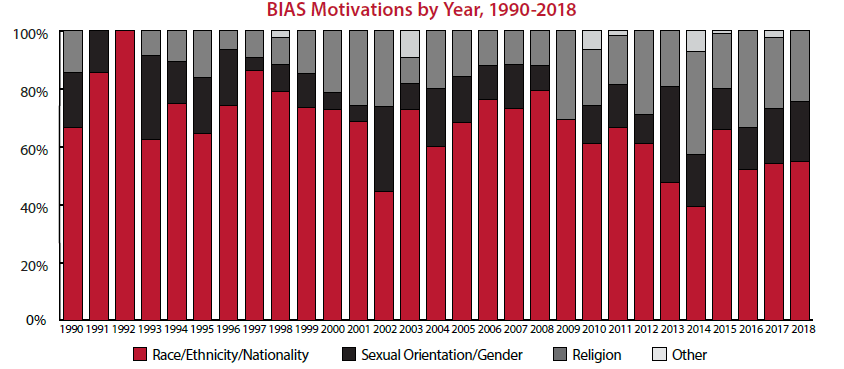- November 02, 2020
- By Jessica Rivinius
Contrary to popular stereotypes that portray United States hate crime offenders as dedicated members of organized groups, new research reveals tremendous diversity in their background characteristics and motivations.
Drawn from a first-of-its-kind database on nearly 1,000 violent and nonviolent hate crime offenders in the U.S. from 1990 to 2018, a new research brief by the University of Maryland’s National Consortium for the Study of Terrorism and Responses to Terrorism (START) shows bias on the basis of race, ethnicity, and nationality were the most prevalent motivations.
 But hate crimes committed by individuals who selected victims because of their sexual orientation or gender identity are rising. Furthermore, hate crimes targeting victims perceived as Latinx and Muslim or Arab grew from less than 5% in the 1990s to nearly a quarter of all attacks over the last two decades.
But hate crimes committed by individuals who selected victims because of their sexual orientation or gender identity are rising. Furthermore, hate crimes targeting victims perceived as Latinx and Muslim or Arab grew from less than 5% in the 1990s to nearly a quarter of all attacks over the last two decades.
“Not every offender commits an act of violence; not everyone is part of an organized group,” said Michael Jensen, START senior researcher and lead investigator of the Bias Incidents and Actors Study (BIAS). “While some offenders carefully plan their crimes to maximize their impact, others act without premeditation in response to prejudices that are pervasive in American communities.”
However, regardless of hate motivation, the START team found that America’s hate crime offenders display significantly higher rates than the general population of low educational attainment, poor work performance, mental illness and substance abuse.
“The criminal backgrounds of offenders are quite high, as well,” Jensen said. “More than 60% of the offenders in BIAS had criminal records prior to committing hate crimes.”
Jensen and his colleagues, Elizabeth Yates and Sheehan Kane, found that among those who committed violent hate crimes, 71% targeted victims on the basis of race, ethnicity or nationality. Attacks targeting African Americans account for more than 40% of the violent and nonviolent crimes in the database, although the prevalence of such attacks fell somewhat in recent years compared to the 1990s, when they accounted for nearly 58% of the total.
Overall, the individuals in the database who selected their victims on the basis of their perceived religion were less often violent than other types of hate crime offenders. These offenders often committed property crimes against symbolic targets, such as mosques and synagogues. At the same time, Jewish targets were greatly overrepresented as victims of mass casualty attacks compared to other types of violent crime. While anti-Semitic perpetrators account for only 10.4% of all offenders in the BIAS data, they comprise over a third (38.1%) of the individuals in the data who planned or committed mass casualty attacks.
The research team also found that although most hate crime offenders had no previous relationship to their victims, nearly 20% of those motivated by anti-Black sentiment, and nearly 30% of those motivated by hate toward women or perceived LGBTQ people knew their victims.
Topics
Research